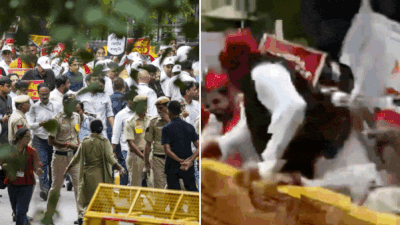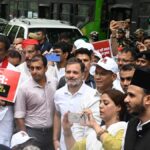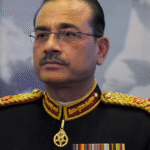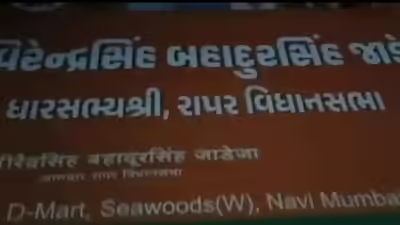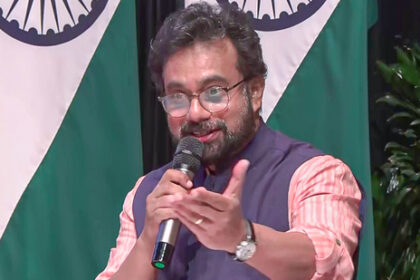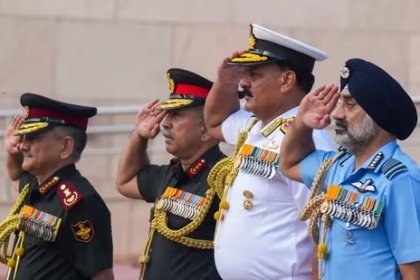High Drama at Opposition March to EC — Akhilesh Yadav Jumps Barricade, Rahul Gandhi Detained
The streets of New Delhi witnessed scenes of high political drama on August 11, 2025, as prominent Opposition leaders, including Rahul Gandhi and Akhilesh Yadav, converged for a protest march towards the Election Commission of India (ECI). The demonstration, aimed at highlighting alleged irregularities in electoral processes and raising questions about the functioning of democratic institutions, quickly escalated into an event that captured the attention of the nation.
From the outset, the march was laden with symbolism. Leaders from various parties under the umbrella of the Indian National Developmental Inclusive Alliance (INDIA) bloc had gathered with the intent of sending a strong, unified message to the ruling government. The issue at the heart of the protest was the so-called “SIR row,” which referred to a series of allegations surrounding suspected voter suppression, intimidation tactics, and discrepancies in electoral rolls. The acronym “SIR” — which had become a rallying cry on social media in recent days — was interpreted differently by different factions, but to the protestors, it symbolized systemic irregularities requiring urgent attention.
The march began at Jantar Mantar, a historical site for civil demonstrations, with a visibly energized crowd. Party flags waved high as chants echoed through the streets: slogans calling for transparency, fairness, and accountability in elections. Television cameras followed every step, broadcasting the march live to millions across India.
However, what began as a largely peaceful demonstration quickly took a dramatic turn as security forces blocked the procession before it could reach the ECI headquarters. The Delhi Police had erected barricades along the designated route, citing “security and law-and-order concerns.” At this point, Akhilesh Yadav, the Samajwadi Party chief, made a bold move that would become one of the day’s defining moments — he leapt over the barricades in a defiant act of protest. The move drew loud cheers from supporters and became an instant viral clip on social media platforms.
Not long after, the situation intensified further. Rahul Gandhi, accompanied by senior Congress leaders, engaged in a heated exchange with police officials on the ground. The standoff culminated in Gandhi’s detention, along with several other key figures from the Opposition bloc. This unexpected escalation not only disrupted the march but also added a fresh layer of political tension to an already charged atmosphere.
By late afternoon, political parties and news outlets were locked in a battle of narratives. While Opposition leaders accused the government of authoritarian tactics and curbing dissent, ruling party spokespersons countered by accusing the march organizers of “manufacturing drama” to gain public sympathy ahead of upcoming state elections.
The SIR row and the events of August 11 have already sparked widespread debate about the health of Indian democracy. Political analysts argue that beyond the theatrics of the barricade jump and the detentions, the underlying issues — from allegations of electoral malpractice to the trust deficit between institutions and political players — warrant serious national introspection.
As the dust settled on the day’s events, one thing was certain: the Opposition’s march to the ECI, despite being cut short, had achieved one of its key objectives — it had seized the nation’s attention. The imagery of leaders defying police barricades and being taken away in detention vans will likely be replayed for weeks to come, influencing political discourse and potentially shaping electoral strategies on both sides.
The unfolding of this protest marks just the beginning of what promises to be a long and contentious battle over the integrity of India’s democratic processes.
To understand the magnitude of the events that unfolded on August 11, 2025, it is essential to trace the roots of the “SIR row” and examine why the Opposition chose this moment to mount such a high-profile protest. While the visuals of leaders leaping barricades and being detained have dominated headlines, the deeper context reveals a political strategy years in the making.
The controversy began several months earlier, when multiple Opposition parties alleged that the Election Commission had failed to address irregularities in the electoral rolls. According to these parties, discrepancies included the presence of duplicate voter IDs, inexplicable deletions of names from certain constituencies, and significant delays in updating changes for newly eligible voters. The term “SIR” — shorthand for Systemic Irregularities in Representation — was coined by activists and political strategists to encapsulate the alleged pattern of malpractice. The phrase gained traction on social media, where it evolved into both a rallying slogan and a trending hashtag.
But the dispute was not merely about administrative errors; it tapped into broader concerns about institutional independence. The Opposition claimed that these electoral issues were not isolated mistakes but symptoms of a deeper malaise: the erosion of checks and balances in Indian democracy. Several parties accused the ruling establishment of influencing supposedly neutral institutions, thereby undermining free and fair elections.
The timing of the protest march was far from accidental. The Opposition bloc — officially known as the Indian National Developmental Inclusive Alliance (INDIA) — saw August 2025 as a critical juncture. With several key state elections scheduled for later in the year, and the general elections only months away, this was a moment to assert their presence, test their street power, and challenge the narrative dominated by the ruling party.
For the Congress Party, the march offered an opportunity to project Rahul Gandhi as a fearless leader willing to confront authority head-on. His detention, though unplanned, played directly into the party’s messaging about the government’s alleged intolerance toward dissent. For the Samajwadi Party, Akhilesh Yadav’s leap over the barricades reinforced his image as a youthful, bold, and rebellious figure capable of energizing grassroots supporters. Other regional parties, from the Trinamool Congress to the DMK, saw in this protest a chance to unify under a common cause without compromising their individual political identities.
The logistical planning behind the march was extensive. Opposition leaders had coordinated routes, slogans, and press coverage in advance. Social media teams were prepared to amplify every moment of confrontation, ensuring the narrative reached urban youth and politically active citizens far beyond the streets of Delhi. When the barricades went up and tensions escalated, the events played directly into these preparations, albeit with a more dramatic flair than anticipated.
However, the government dismissed the entire episode as a “staged spectacle,” accusing the Opposition of manufacturing a crisis to distract from its own failures in governance. Official statements from ruling party leaders emphasized that the Election Commission operates independently and that no credible evidence of large-scale voter fraud had been presented. They framed the barricade jump and detentions as irresponsible acts that disrupted public order and inconvenienced citizens.
Political observers remain divided on the impact of the protest. Some see it as a turning point that could galvanize disillusioned voters and rally anti-incumbency sentiment. Others warn that the theatrics may alienate moderate voters who prefer institutional engagement over street confrontation. Nevertheless, the August 11 protest has cemented the “SIR row” as a defining political issue in the months leading to the elections.
In the days following the march, the Opposition announced plans for a nationwide campaign to “protect the vote,” promising rallies, public consultations, and legal action to challenge alleged electoral irregularities. Whether this movement will translate into tangible electoral gains remains to be seen — but its visibility and momentum are undeniable.
August 11, 2025: A Day of Confrontation and Symbolism
The morning of August 11, 2025, began like any other humid monsoon day in New Delhi. But as the city stirred awake, a different kind of storm was brewing in the heart of the capital. The Opposition’s much-publicized march to the Election Commission headquarters was scheduled for late morning, but signs of the brewing confrontation were visible hours before the first leaders arrived.
By 7:30 AM, barricades had been erected along several strategic points, most notably on Ashoka Road and the approach to Nirvachan Sadan, the Election Commission’s office. Delhi Police, working under instructions to maintain “law and order at all costs,” deployed riot control units, mounted patrols, and multiple layers of cordon security. In a city used to political rallies, this level of preparedness was telling.
Around 9:15 AM, the first groups of protestors began to arrive — party workers carrying flags, placards, and banners emblazoned with “#SaveOurVote” and “No to SIR.” By 10:00 AM, the crowd had swelled into the thousands, a patchwork of supporters from the Congress, Samajwadi Party, Trinamool Congress, DMK, Left parties, and smaller regional outfits. The chanting was relentless, echoing through the narrow streets: “Tanashahi Nahi Chalegi” (Dictatorship will not be tolerated) and “Loktantra Bachao” (Save Democracy).
The high drama began around 10:45 AM when senior leaders — Rahul Gandhi, Akhilesh Yadav, Mallikarjun Kharge, and several other Opposition figures — arrived together, walking side-by-side. This carefully choreographed show of unity was meant to send a message: despite ideological differences, the Opposition stood together against what they saw as an existential threat to democratic fairness.
The first barricade was encountered at the junction near Jantar Mantar. Here, police requested the leaders to submit their memorandum without proceeding further, citing security concerns. The Opposition leaders refused. Television cameras caught the tense exchange, with Rahul Gandhi insisting, “We are elected representatives of the people — we have the right to go to the Election Commission.”
Then came the moment that would dominate headlines. At precisely 11:02 AM, Akhilesh Yadav, visibly frustrated by the stalemate, took a few steps back, sprinted forward, and leapt over the waist-high barricade in a single motion. The crowd erupted. Party workers surged forward, clapping, shouting slogans, and recording the moment on their phones. This single act, as impulsive as it appeared, instantly transformed the day into a political spectacle.
Police reinforcements moved in quickly. Leaders were physically blocked from advancing further. Rahul Gandhi attempted to push forward, but was restrained and eventually escorted to a waiting police bus. Other leaders, including Kharge and Derek O’Brien, were similarly detained. The detentions, though temporary, were immediately broadcast across national news channels and livestreamed on social media platforms, creating a flurry of viral clips.
By noon, the area resembled a high-stakes political theatre. The detained leaders were taken to temporary holding facilities, while their parties issued fiery statements condemning the “illegal and undemocratic” police action. On the streets, party workers continued to hold their ground, chanting and waving flags despite intermittent rain showers.
Inside the Election Commission office, officials maintained that they had been willing to receive a delegation and review the memorandum, but insisted that crowd control measures were necessary to prevent disruptions. The government’s spokesperson, addressing the media later in the afternoon, accused the Opposition of deliberately provoking police action for political mileage.
But to the Opposition, the events of the day had already achieved their purpose. The visuals of Akhilesh Yadav jumping barricades and Rahul Gandhi being led away by police became symbolic — not just of resistance to the SIR controversy, but of a broader narrative about democratic rights, institutional accountability, and the right to dissent.
By evening, the detained leaders were released, walking out to cheering supporters and camera flashes. Rahul Gandhi, still visibly charged, addressed a brief gathering, declaring, “This is just the beginning. We will not rest until the vote of every Indian is protected.” Akhilesh Yadav, with a characteristic smirk, quipped to reporters, “Barricades are for stopping injustice, not people.”
That night, political talk shows dissected every second of the day’s footage. Analysts debated whether the events marked a turning point in Opposition unity or a one-day burst of theatrics. Hashtags like #AkhileshJump and #RahulDetained trended for over 24 hours, ensuring the protest stayed at the center of national attention.
The events of August 11, 2025, did not fade into the background once the rain-soaked streets emptied and the detained leaders returned home. Instead, the day became a pivot point, shaping the political conversation for weeks. The barricade jump, the detentions, and the charged slogans were replayed endlessly — each time with a slightly different narrative depending on the speaker and the platform.
In Parliament: An Arena of Escalation
When Parliament reconvened the next day, the mood was combustible. The Opposition, still riding the adrenaline of the protest, stormed into the session wearing black armbands. They carried placards reading “#NoToSIR” and “Democracy in Danger,” defying the Speaker’s repeated calls to maintain decorum. Slogans from the street seemed to have seeped into the Lok Sabha, echoing from the Opposition benches with relentless force.
The Treasury benches, meanwhile, came prepared for a counterattack. The Home Minister accused the Opposition of “manufacturing chaos” and “misleading the public” about the Secure India Referendum (SIR). In a fiery speech, he claimed the SIR was “purely consultative” and would “strengthen, not weaken, the electoral process.” But each sentence was drowned out by Opposition MPs pounding their desks and shouting for a complete rollback.
When footage of Akhilesh Yadav’s barricade leap was mentioned, ruling party MPs mocked it as “political gymnastics,” prompting an uproar that led to repeated adjournments. By mid-afternoon, the Speaker suspended several MPs for “gross disorderly conduct,” a move the Opposition claimed was yet another example of silencing dissent.
Media Spin: Two Nations, Two Stories
On television, India seemed to split into two parallel realities. Pro-government channels portrayed the protest as reckless, highlighting images of jostling crowds and warning about “security risks” to the Election Commission building. Political analysts sympathetic to the government argued that the Opposition had no substantive case and was only trying to generate viral moments ahead of upcoming state elections.
Conversely, independent and Opposition-friendly platforms framed the day as a triumph of people’s resistance. Editorials compared the barricade jump to iconic acts of civil disobedience in India’s political history. Social media influencers, activists, and even some retired bureaucrats hailed the protest as a “reminder that institutions belong to the people, not the ruling party.”
Hashtags like #LoktantraBachao and #DemocracyVsDictatorship clashed with #DramaPolitics and #OppositionStunt in an online war that showed no sign of cooling. Meme culture quickly claimed its share, with Akhilesh’s leap becoming a template for everything from cricket jokes to satire about bypassing bureaucracy.
Opposition Strategy: Seizing the Momentum
Behind closed doors, the Opposition’s coordination committee met the very next evening at a senior leader’s residence in Delhi. The consensus was clear: the August 11 protest had injected fresh energy into their campaign, and they needed to sustain it. Plans were drawn up for state-level marches, joint rallies, and a national “Save Democracy Yatra” to keep the SIR controversy alive in public consciousness.
Rahul Gandhi pushed for a sustained social media blitz, arguing that the battle was as much about narrative as it was about legislative pressure. Mamata Banerjee and MK Stalin, dialing in remotely, suggested focusing on smaller towns and rural belts where the SIR’s implications were poorly understood but could spark deep concern if explained in relatable terms.
Government Counter-Moves: Controlling the Narrative
Sensing that the Opposition was gaining traction, the ruling party rolled out a counter-offensive. Cabinet ministers fanned out across television studios and public events, repeating the message that the SIR was a “people’s consultation,” not an attempt to tamper with the electoral system. Government social media handles released slick infographics, and influencers supportive of the administration began posting explainer videos downplaying Opposition claims.
In a notable move, the Prime Minister himself addressed a youth gathering in Varanasi, urging citizens to “trust in the democratic institutions that have served the nation for decades.” Without naming the Opposition directly, he warned against “those who thrive on confusion and chaos.” The statement was widely interpreted as a veiled response to August 11.
Public Sentiment: A Nation Watching Closely
Surveys conducted in the week after the protest showed a polarized but deeply engaged electorate. Among urban youth, the protest — especially the viral barricade jump — had sparked curiosity and even admiration for the Opposition’s boldness. In rural areas, awareness of the SIR remained patchy, but the narrative of “saving democracy” resonated in pockets where trust in institutions was already fragile.
Meanwhile, civil society groups and former Election Commission officials began calling for open public consultations on the SIR, arguing that transparency was the only way to dispel suspicion. These voices, while not directly aligned with the Opposition, indirectly added pressure on the government.
Setting the Stage for the Next Confrontation
By the end of August, it was clear that the SIR controversy was no passing storm. Both sides had invested heavily in their narratives, and neither seemed willing to back down. The Opposition’s next big move — a planned nationwide human chain on September 2 — was already being billed as a “showdown moment.” The government, for its part, was tightening security protocols around key institutions, determined to avoid another scene like August 11.
The barricades of Delhi had become more than physical obstacles; they were now political symbols. And in a country where symbolism often drives public opinion as much as policy, both the ruling party and the Opposition understood that the next act of this confrontation would be decisive.
Also Read : Opposition INDIA Bloc Marches to Election Commission Amid “Vote Chori” Allegations


